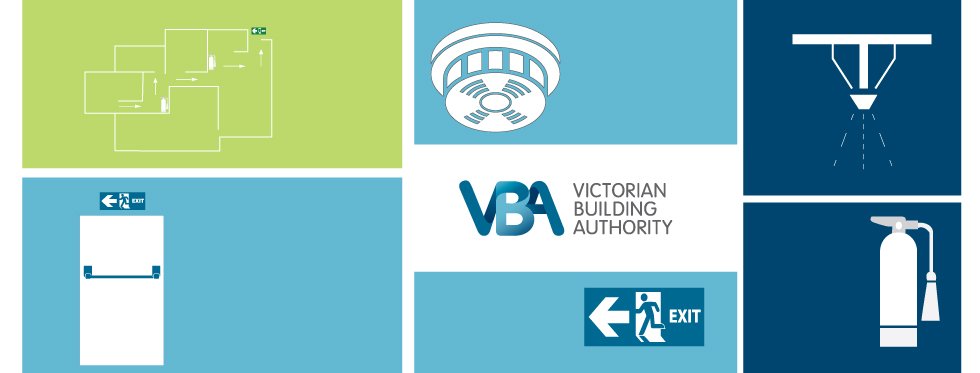
The following content has been prepared and provided by the Victorian Building Authority (VBA)
When the construction of a building is complete, the building owner is responsible for its upkeep and maintenance, particularly its safety features or essential safety measures.
The maintenance of essential safety measures will ensure that important safety systems within the building remain at the required operational level throughout the life of the building. The type of maintenance needed depends on the complexity of the safety measures, equipment of feature and the maintenance program required or expected at the time of installation.
Download Essential Safety Measures fact sheet >
Essential Safety Measures Maintenance Manual (Fourth edition)
The Essential Safety Measures Maintenance Manual should be on the bookshelf of every person or organisation responsible for maintaining buildings.
The purpose of the manual is to set out in detail the requirements and the parameters building owners and managers must work within, to meet their regulatory obligations.
The approach to maintenance outlined in the 4th edition is the same as previous editions. The 4th edition is set out in four easy-to-use sections:
- Part 0 – Alternative Solutions —summarises the performance-based structure of the Building Code of Australia to clarify the impact the use of alternative solutions has on maintenance
- Part 1 – Buildings built after 1 May 2004
- Part 2 – Buildings built between 1 July 1994 and 1 May 2004
- Part 3 – Buildings built prior to 1 July 1994.
What is an essential safety measure?
The term ‘essential safety measure’ is defined in Part 12 of the Building Regulations 2006 (the Regulations) and includes items listed in Schedule 9 of the Regulations, such as:
- Air handling systems (used for smoke hazard management)
- Exit doors
- Early warning systems
- Emergency lifts
- Emergency lighting
- Emergency power supply
- Emergency warning systems
- Exit signs
- Fire control centres
- Fire curtains and doors
- Fire extinguishers
- Fire detection and alarm systems
- Fire hydrants
- Fire-isolated stairs
- Fire rated materials
- Fire windows
- Mechanical ventilation (incorporate a cooling tower or hot or warm water system)
- Fire isolated passageways and ramps
- Paths of travel to exits
- Smoke alarms
- Smoke control systems
- Sprinkler systems
What types of buildings are affected?
All buildings other than a house or outbuilding are affected. These include the following Classes which are defined in A3.2 of the National Construction Code Series Volume One, Building Code of Australia Class 2-9 buildings (BCA):
- Class 1b: Some boarding houses, guest houses or hostels
- Class 2: Buildings containing sole-occupancy units which are dwellings (e.g. apartments, blocks of flats)
- Class 3: Backpacker accommodation, residential parts of hotels or motels, residential parts of schools, accommodation for the aged, disabled or children
- Class 4: A dwelling in another class of building
- Class 5: Offices for professional or commercial purposes
- Class 6: Shops or other buildings for sale of goods by retail, including cafés, restaurants, milk bars, dining rooms, and bars
- Class 7: Buildings used for car parks, storage or display of goods
- Class 8: Laboratories or buildings for production or assembly of goods
- Class 9: Public buildings such as health care buildings or assembly buildings, nightclubs, bars etc.
What does the law require?
The Regulations require the building owner to maintain essential safety measures so that they operate satisfactorily.
There are different obligations under the Regulations dependent on when the building was built or when building work occurred on the building.
Part 12 of the Regulations contains three divisions. Division 1 deals with maintenance of buildings and public entertainment, Division 2 deals with swimming pool and spa maintenance and operation, and Division 3 deals with private bush fire shelter maintenance and operation.
Division 1 is then further divided into 3 subdivisions:
- Subdivision 1 – buildings constructed or altered since 1 July 1994,
- Subdivision 2 – buildings constructed before 1 July 1994,
- Subdivision 3 maintenance of exits and paths of travel.
What are my responsibilities?
Councils have responsibility under the Act for the enforcement of building safety within their municipality.
The municipal building surveyor or chief officer of the relevant fire authority is responsible for the enforcement of the maintenance provisions of the Regulations.
Building occupiers have an obligation to ensure all exits and paths of travel to exits are kept readily accessible, functional and clear of obstructions. Building owners must ensure that an essential safety measure is maintained so that it operates satisfactorily.
Building owners must prepare an annual essential safety measures report on the buildings essential safety measures. They may authorise an agent, such as a specialist maintenance contractor, to complete the report. The annual essential safety measures report is to be in accordance with the approved form.
The owner must also keep records of maintenance checks, safety measures and repair work so a municipal building surveyor or chief officer of the fire brigade can inspect them. These documents must be made available to the municipal building surveyor or the chief officer on request after 24 hours’ notice has been given. Annual essential safety measure reports and records of maintenance checks, safety measure and repair work must be made available for inspection on request after 24 hours’ notice has been given.
If building work is proposed to alter an existing building it may have an effect on essential safety measures, so it is worth checking with a municipal building surveyor or private building surveyor to see what needs to be done to comply with the Act and the Regulations.
Buildings built before 1 July 1994.
If the building was built before 1 July 1994, the owner is responsible for ensuring that any safety equipment, safety fittings or safety measures are maintained and fulfilling their purpose. This includes exits and paths of travel to exits.
Buildings constructed or altered since 1 July 1994
If the building was constructed or altered since 1 July 1994, the list of essential safety measures, including their performance level, frequency and type of maintenance required would be included with the occupancy permit or certificate of final inspection.
The owners of all Class 9 buildings, and Class 2 to 8 buildings constructed or altered since 1 July 1994, must have a current copy of the building’s occupancy permit on display in the building. These can be framed, placed in a sealed, transparent or glass covered notice board or for multiple pages, the pages may be laminated so they can be suspended or fixed in a prominent position in the building as approved by the building surveyor.
Adequate maintenance is the best means of ensuring that fire safety systems will operate reliably if an emergency arises. Through meeting these requirements the owner will have greater knowledge of the safety and condition of their building.
What happens if an owner doesn’t comply?
Non-compliance may result in an infringement notice being issued by Council or the Fire Authority with a fine of over $290 and furthermore, non-compliance may result in prosecution in which a fine may be imposed of over $1,400 under the Regulations, or of over $17,000 for an individual or over $88,000 for companies for each breach. More importantly, non-compliance could place not only building occupants at risk but also those of passers-by and the occupants of adjoining buildings.





